
15 minute read
California’s Ever-Present Relationship with Fire — And How To Deal
By Scot Pipkin, Director of Education and Engagement
When I was five years old, my family moved to a neighborhood that borders a large open space in San Diego. Our cul-de-sac was the last street in the development, and we were all pleased with the mountainside views from the front door. We had only been living in the new house for a few months when we were evacuated due to wildfire.
It was Labor Day weekend, and the neighborhood kids had all been swimming in one of the backyard pools. Suddenly, the smell of smoke filled the air, and we rushed out of the pool. I remember standing in the front yard of our new home and seeing flames rise over the ridge. We packed quickly, leaving lunch half prepared on the counter as we evacuated. Upon returning to our home, the sandwiches were still sitting on the kitchen counter, the bread toasted from the heat of the blaze, and a fine layer of ash coated all interior surfaces.

By California standards this Assist 78 fire (any fire along state Route 78) was tiny. At 935 acres (378 hectares), it pales in comparison to recent and historic fires of tens or even hundreds of thousands of acres. Fifteen years later, while I was away at college, my parents were once again evacuated by wildfire as the 270,000-acre (109,265-hectare) Cedar Fire threatened their neighborhood.
Our Shared History With Fire
After fire has once again viscerally affected the Southern California consciousness, I find myself reflecting on my family’s experiences with wildfire and the reality of fire throughout California. I’ve been lucky in that my childhood home and neighborhood in San Diego have sustained minimal fire damage. Relatively speaking, Santa Barbara Botanic Garden has also been fortunate. Though the Jesusita Fire of 2009 burned 80% of the Garden and much of Mission Canyon, most buildings were saved and many plants have bounced back. There’s also been the Tea Fire, the Coyote Fire, the Sycamore Fire, and the Thomas Fire that have destroyed so much just outside the Garden’s boundaries. As fire looms large for many of us, one wonders how we can protect our homes and neighborhoods in the face of something that seems probable, if not inevitable.
Wildfire is an important part of the ecological equation throughout California and the West. Our plants are adapted to respond to fire, either by resprouting from specialized roots (lignotubers) or as a trigger for seed germination. California’s native plants present a resilient choice for landscaping in our region. We also know that humans play a critical role in fire ignition.
Historically, in California and throughout the globe, humans have used fire as a tool for engineering landscapes that favor useful and culturally significant plants and as a tool for renewal. Today, fire is still very much a part of the human relationship with the natural world.


Plant Physiology and Whiplash
If you’ve ever tried to start a campfire with wet or “green” wood, you know how difficult it can be to ignite moisture-laden material. Fire is, of course, most devastating when it encounters dry “fuel.” California’s Mediterranean-type climate with dry summers ensures that soils have limited moisture by September to October each year. Sunny, warm conditions during the summertime months mean that plants are photosynthesizing. As a result, the plants’ leaves will have open stomata releasing water vapor into the dry air. In response to water loss during photosynthesis, plant roots will attempt to draw whatever moisture they can from the ground. In very dry conditions, this puts a lot of stress on the plant, leading to the need for specialized adaptations including deep roots that can access ground water, leathery (sclerophyllous) leaves that reduce water loss during photosynthesis, and summer dormancy (drought deciduousness) in many of California’s native plants. Even with these adaptations, by the end of a hot, dry summer, plants across Southern California have seriously low levels of water in their tissues. This is when our plants are the most susceptible to fire, hence the concept of a “fire season” associated with post–dry season conditions that often happen to coincide with high winds that originate in hot deserts and valleys.
Over the last few years, California has experienced a phenomenon described in the literature as “hydroclimate volatility,” referring to the seesaw patterns in rainfall we’ve experienced. Another more colorful term that is being used to describe this concept is “whiplash” (Swain et al., 2025, 3550). In 2023 and early 2024, California experienced tremendous precipitation years, but by the summer of 2024, the rain spigot seemed to turn off. This past June through December 2024 were extremely hot and dry, and the abundant growth resulting from two wet years suddenly dried up (Madakumbura et al., 2025).
This phenomenon seems partly driven by the fact that warm air has a higher capacity for holding moisture than cooler air. As our climate warms, the atmospheric “sponge” can hold, and eventually release greater quantities of precipitation. The result is that California and other locations worldwide are likely going to experience unpredictable periods of extreme wet, followed by extreme heat and dryness. In these times, we can expect our fire seasons to be commensurately mild or extreme, depending on which part of the seesaw we are experiencing (Swain et al., 2025, 1-4).
As if this uncertainty and instability weren’t enough, the steady march of habitat conversion due to resource extraction and development has changed both fire frequency and impacts in our region. According to Denise Knapp, Ph.D., director of conservation and research at the Garden, “In much of Southern California, humans have increased the fire frequency beyond natural levels, and this can lead to a complete conversion to invasive, nonnative grasses, which has terrible consequences for the web of life.
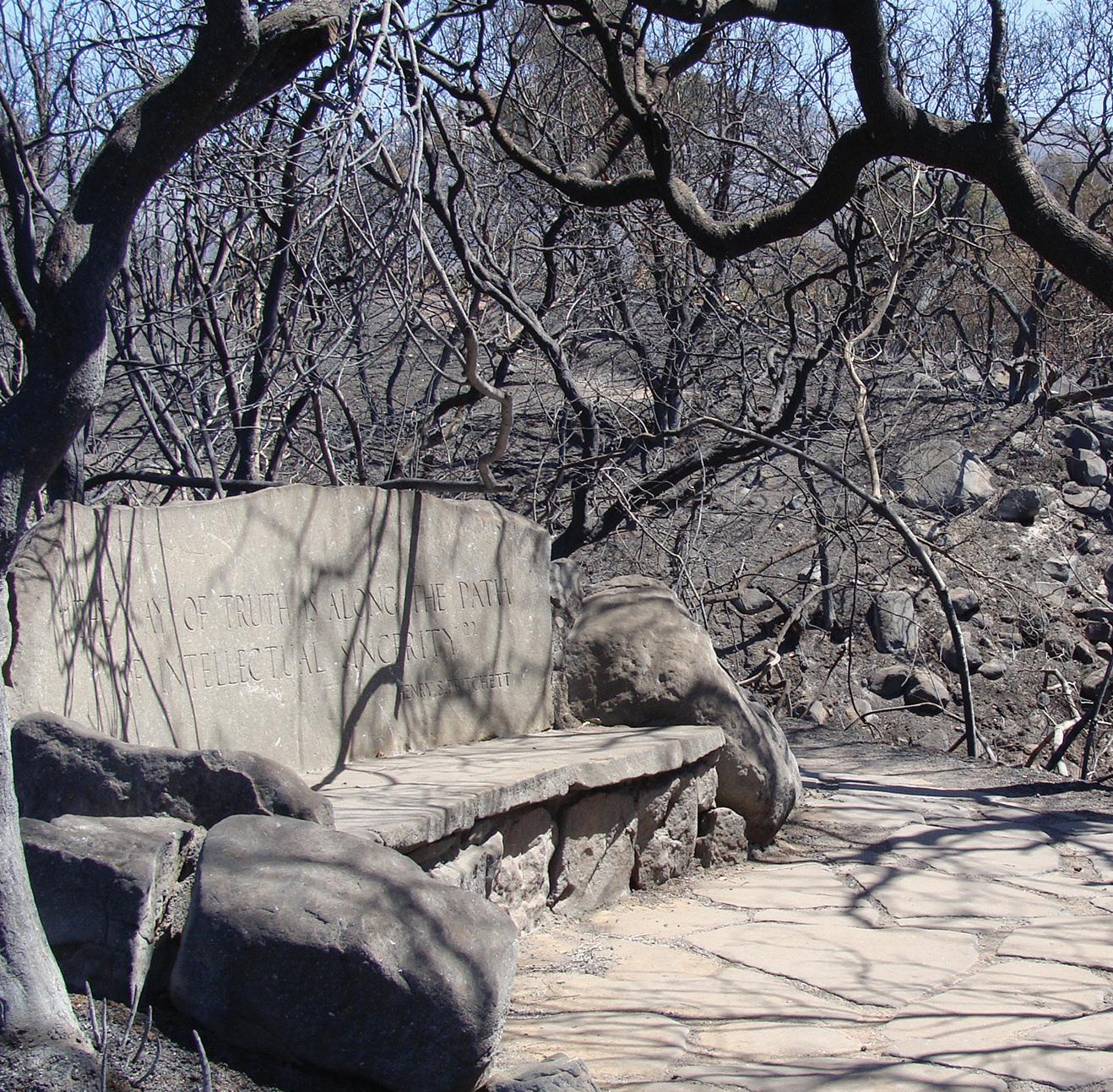
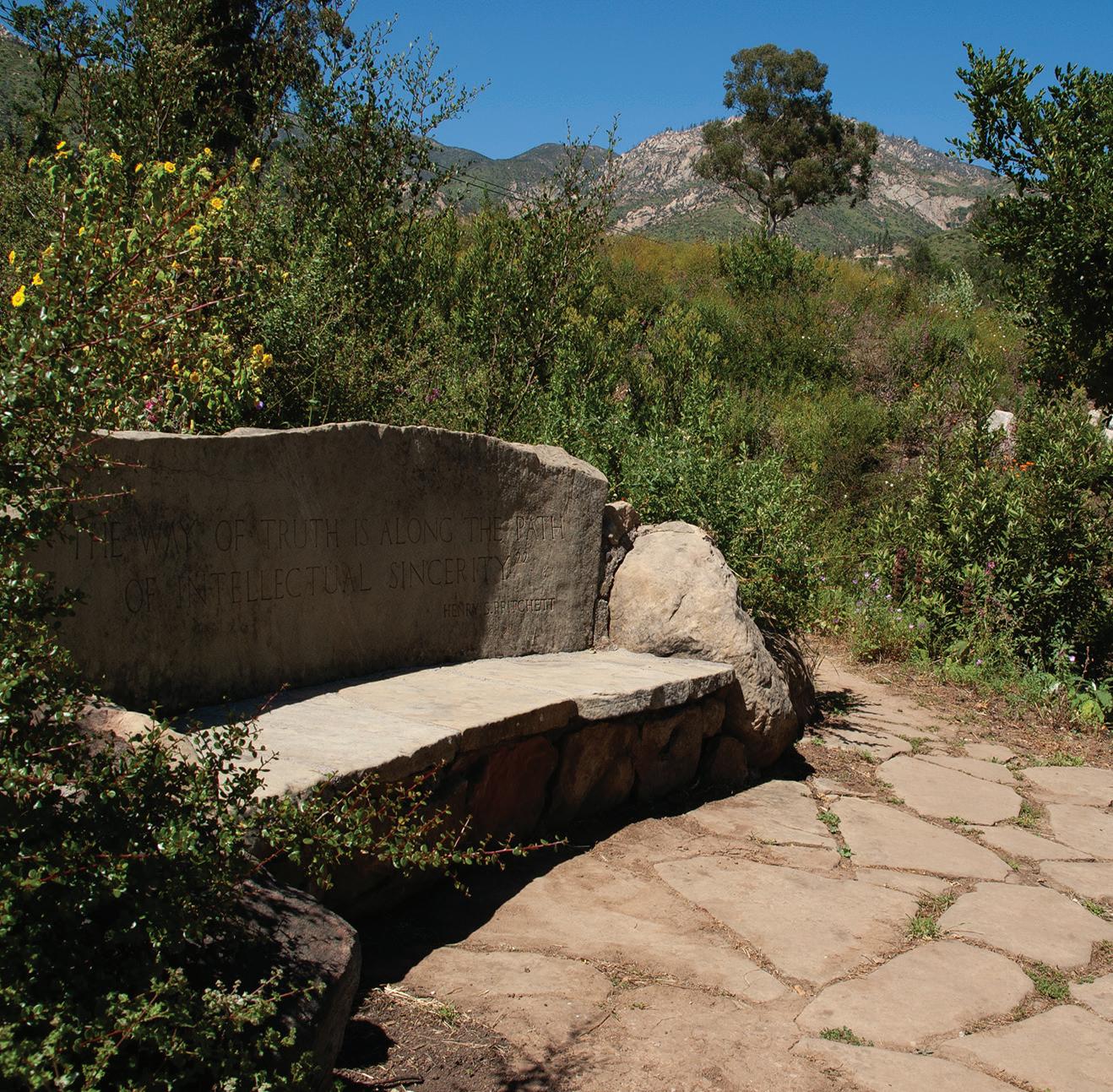
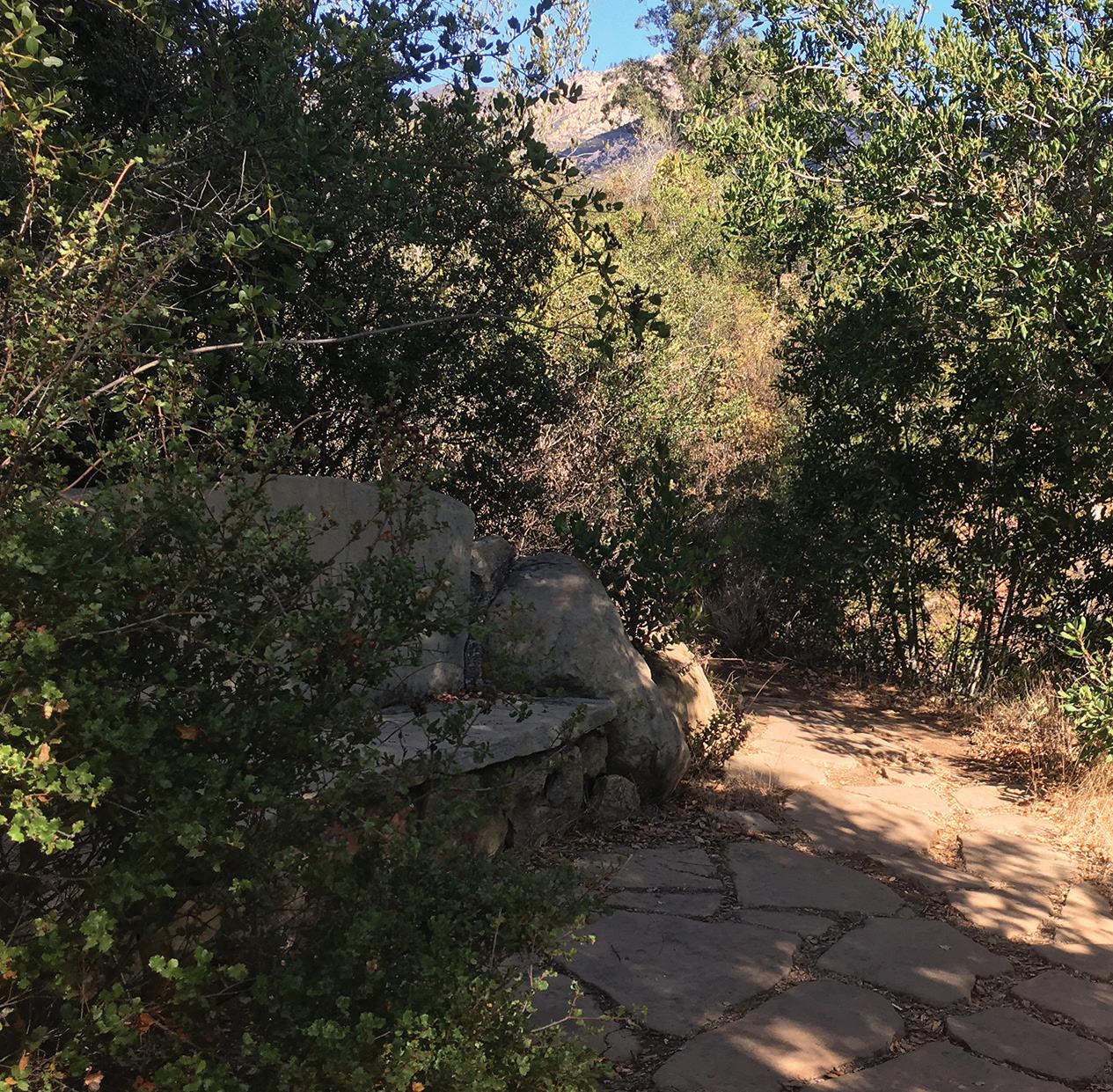
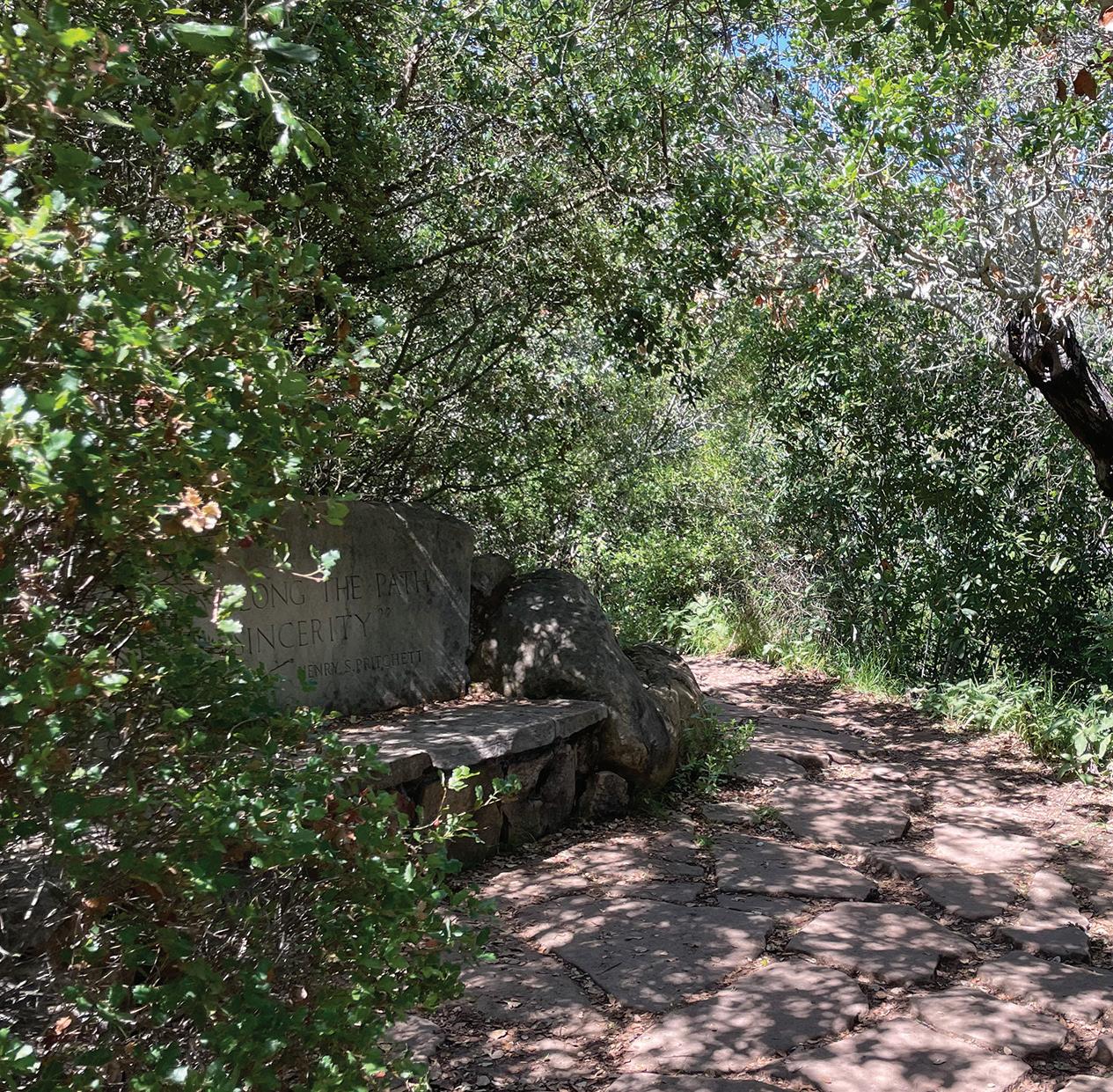
Home Hardening
So, where do we go from here? As fire sits top of mind and many of us are beginning to prepare for another year of native plant gardening in California, what are the steps we should take to ensure biodiversity, create a sense of place, and proactively protect our communities?
Evidence from the last several decades suggests that there are some key steps homeowners can take to minimize the potential for catastrophe in the event of a wildfire. This begins with an approach that starts from the home (or other structure) and works outward. The concept of home “hardening,” or resistance to fire, is one we should all consider immediately. And it starts with an understanding of how our homes might catch fire to begin with. Contrary to the common image of a sea of flames engulfing our homes during a wildfire, most houses will ignite from embers carried by the wind. Those embers may land in a compromised part of the structure and start a blaze from that point of weakness.
According to Matthew Caliguire from Allen Construction — a local builder in Santa Barbara who has employed fire-wise design for both new construction and rebuilds after wildfire — these are the most important things homeowners can do right now:
1. Check your roof, gutters, and vents
Install or inspect vent covers (1/8-inch [3 millimeter] metal mesh) to prevent embers from entering attics and crawl spaces
Ensure your roof is made of fire-resistant materials (metal, tile, asphalt shingles rated Class A)
Clear debris: Clean gutters and roof valleys of leaves and pine needles
Install gutter guards: Prevent debris build-up with metal guards
2. Inspect for and seal gaps
Siding, decking, and eaves are the common locations where embers can get stuck
Use fire-resistant caulk, paint, or weatherstripping to seal openings
3. Have an emergency plan
Keep a fire extinguisher accessible and verify it is fully charged
Check hoses are long enough to reach all parts of the property
Review your emergency evacuation plan and have important items ready
As we think about how our landscapes might impact fire behavior on our properties, it’s useful to consider the defensible space zones that are outlined by state and county ordinances. In areas mapped as “high fire risk,” the county fire department will perform inspections annually. But regardless of your fire-risk designation (found on your county fire department’s website), it’s not a bad idea to consider these zones:
Zone 0
The first zone outward from a structure is Zone 0, which extends 0 to 5 feet (1.5 meters) from the structure. Here, the recommendation is to limit plant materials and eliminate plant-based mulches to suppress potential for materials to catch fire and send embers into the structure. Mineral soil, gravel, and other nonflammable substrates are the recommended treatment here. If the thought of not having plants within 5 feet (1.5 meters) of your house is unbearable, you could consider container plantings of succulents (Dudleya spp., Sedum spp., or members of the Family Cactaceae), annual wildflowers, or small herbaceous perennials.
Zone 1
Past 5 feet (1.5 meters), Zone 1 begins, extending to about 30 feet (9 meters) from the structure. In Zone 1, plants are welcome, but their size and spacing become critical factors to consider. The recommendation is to keep it “lean, mean, and green” (Defensible Space | CAL FIRE, n.d.).
Zones 2 through 4
Zone 2 is the next defensible space zone, at 30 to 100 feet (9 to 30.5 meters) from the home. Zone 3 is the “access zone,” a space that is maintained to give emergency responders clear access to your property. Some references also talk about Zone 4, community areas and rights-of-way.
Defensible space literature is abundant and growing. There is neither room in this article or in the author’s brain to effectively convey the extensive literature on the subject. However, some recommended reading can be found at the Santa Barbara County Fire website, through the Santa Barbara County Fire Safe Council, and in the California Chaparral Institute’s “From the House Outward” document. The book “Firescaping: Protecting Your Home With a Fire-Resistant Landscape” by Douglas Kent is also a handy reference.

Emerging Research in Plant Flammability
Max Moritz is a regional fire specialist with University of California Agriculture and Natural Resources; adjunct professor at University of California, Santa Barbara’s Bren School of Environmental Science & Management; and board member at the Santa Barbara County Fire Safe Council. For the last couple of years, he and his lab have been conducting experiments to better understand how fire impacts California’s native plants. Some of these experiments involve clipping living branches off plants from multiple sites (including specimens from the Garden) and burning them in an experimental chamber.
The researchers then measure time to ignition, duration of flames, flame height, etc., which can be compared to plant characteristics such as hydration level, leaf density, and amount of volatile organic compounds. While it’s easy to romanticize how this research might soon lead to guidelines for landscaping and gardening in fire country, Max was quick to tell me, “It’s still quite difficult (and risky) to generalize.” That said, it does appear that some patterns are emerging. For one, it seems that plants with deeper roots might have access to moisture during the driest times, making them less susceptible to ignition than shallow-rooted plants. One example of a deeperrooted plant is lemonade berry (Rhus integrifolia). This is not a panacea or “silver bullet” plant, but lemonade berry does exhibit some promising characteristics of a more fire-resistant plant.
In terms of plants to absolutely avoid, Max says, “Some key [species] such as Italian cypress and many palms, are probably good to avoid in nearly all circumstances.” Since most of those are nonnative plants, the Garden wouldn’t recommend them anyway. So, if you have Italian cypress (Cupressus sempervirens) or palms, including the native California fan palm (Washingtonia filifera) on your property, you might want to assess those choices.
As this research continues and Max’s lab tests the flammability of more plants, we will glean even more information about the characteristics that contribute to a plant’s flammability. Organizations like the Garden will be working with research teams to identify native plants and horticultural varieties to test so we can have more accurate information for concerned residents.
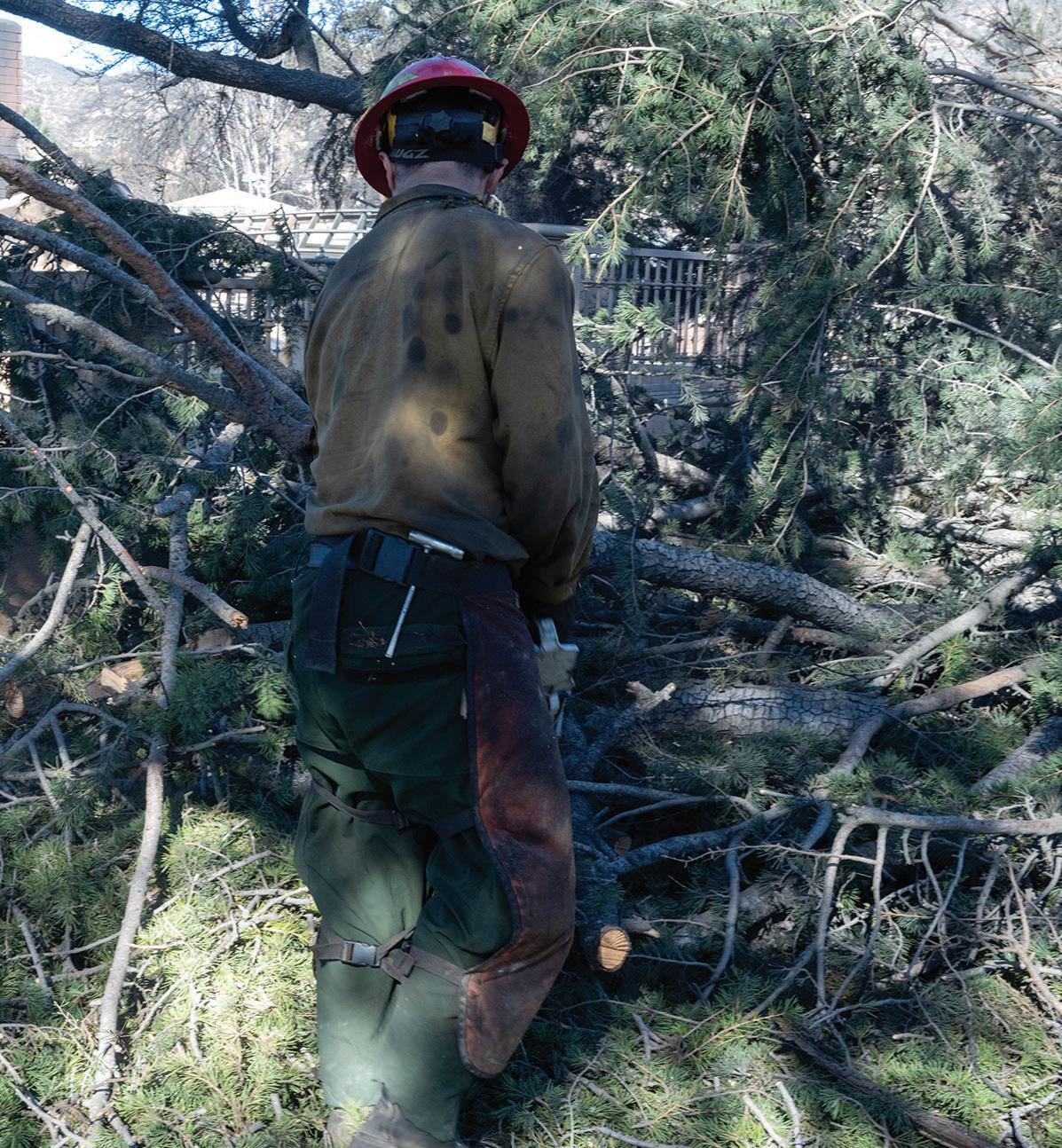
Fire-Wise Maintenance
“Gardening is a relationship.” This is a refrain I have frequently been discussing with Alejandro Lemus, horticultural educator at the Garden. Regarding wildfire, the relationship you have with your landscape can be crucial. As noted above, considering the location spacing of plants is important for managing embers flying toward your home. How you maintain your plants can be equally important. Supplemental watering during a dry fall/winter could bolster your plants through the dry season. Additionally, plants with less interior dead material and more open shapes due to pruning may also reduce the potential ember production near a home. Bear in mind that denuding your plants will diminish their value for bird nesting and other ecological benefits, so exercise judgement when maintaining your landscape and favorite plants. When gardening for fire safety, the most important tasks are to use the defensible space guidelines, space your plants appropriately, and maintain your plants to keep them hydrated and largely free of dead material or overly dense growth.
As always, thinking about the seasonality of your garden is going to be a big part of your relationship with the plants. Consider whether you are able to install plants whose seasonality aligns with maintenance for fire safety. Plants such as bush sunflower (Encelia californica), Coulter’s Matilija poppy (Romneya coulteri), elderberry (Sambucus spp.), and deergrass (Muhlenbergia rigens) can all be pruned back significantly in late summer as soil moisture decreases and plants get more stressed and susceptible to ignition.
Beyond building a relationship with our own gardens, there are plenty of things we can do to advocate for more fire-wise planning in our communities. As Eric Cárdenas, the Garden’s director of impact and advocacy, says, “We should all be working with our elected officials to find ways to incentivize or subsidize the implementation of [fire-wise] practices. When fire prevention strategies are designed to displace native plant ecosystems, including the chaparral ecosystems that dominate much of Southern California, we are using up precious financial resources that detrimentally impact native habitat while simultaneously throwing money at a ‘solution’ that really doesn’t work.”
Ever Grateful, Ever Vigilant
As I sit in Mission Canyon, typing these words, I’m keenly aware that my lucky streak with fire might not last forever. The right (or wrong) combination of weather and human activity could turn everything upside down. Moreover, it’s tough to stomach that a wind-driven fire could still have devastating effects, despite my best efforts to be fire-wise. While the weight of that reality is certainly unnerving, it’s also galvanizing to know that I’m in a community that takes wildfire seriously and that there are simple steps I can take today which might save me from catastrophe in the future. Now, onward to check my home’s eaves and do some maintenance on Zones 0 and 1.
CITATIONS
Defensible Space | CAL FIRE. (n.d.). Cal Fire. Retrieved April 22, 2025, from https://www.fire. ca.gov/dspacehttps://www.fire.ca.gov/dspace
Madakumbura, G., Thackeray, C., Hall, A., Williams, P., Norris, J., & Sukhdeo, R. (2025, January 13). Climate Change a Factor in Unprecedented LA Fires. UCLA Sustainable LA Grand Challenge. https://sustainablela.ucla.edu/2025lawildfires
Swain, D. L., Abatzoglou, J. T., Albano, C. M., Brunner, M. I., Diffenbaugh, N. A., Kolden, C., Prein, A. F., Singh, D., Skinner, C. B., Swetnam, T. W., & Touma, D. (2025). Increasing Hydroclimatic Whiplash Can Amplify Wildfire Risk in a Warming Climate. Global Change Biology, 31(2), 1-4. https://doi.org/10.1111/gcb.70075
Swain, D. L., Prein, A. F., Abatzoglou, J. T., Albano, C. M., Brunner, M., Diffenbaugh, N. S., Singh, D., Skinner, C. B., & Touma, D. (2025, January). Hydroclimate Volatility on a Warming Earth. Nature Reviews: Earth & Environment, 6, 35-50. https://doi.org/10.1038/s43017-024-00624-z










